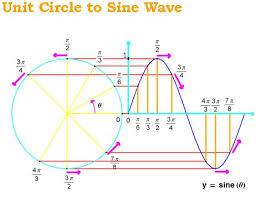Overview
Circular trigonometric functions can be applied to situations in physical, biological, and social sciences involving data that follows a pattern that is not linear. Many of those patterns are periodic, and can be modeled by approximations of sine, cosine, or other functions.
The Sine and Cosine Waves
The numerical value of t around the unit circle has the same value whether it is represented by 2π or τ, 4π or 2τ, and so on. Therefore, a sine function can be graphed as sin (t +2nπ) = sin t and a cosine function can be graphed as cos (t +2nπ) = cos t, for any real integer n. Both the sine wave and the cosine wave are periodic and repeat their graphs symmetrically.
Amplitude, Period, and Phase Shift
The period is the time it takes for a complete cycle through all values, from the beginning through the highest point to the baseline down to the lowest point, then back to baseline again. The amplitude is the highest point of the t curve and the absolute value of the lowest point, often represented by the letter a. A curve can be shifted horizontally by moving it left or right, called the phase shift. In trigonometric language, a sine wave can be represented by the expression y = a sin kx, and a cosine wave can be represented by the expression y = a cos kx.
Oscillations
Many things are variable in nature, and follow a sine wave, a cosine wave, or a combination of different types of waves. Electromagnetic energy, whether infrared, visible light, UV light, X-rays, microwaves, or sound waves follow periodic oscillations and can be modeled by periodic oscillations. The period of variable stars can also be measured and calculated. The motion of a pendulum or electrical currents also can be measured using periodic functions.
Other Periodic Functions
Behavior that can be modeled by sine, cosine, and combinations of waves occurs in biology, physiology, and other social sciences. Populations of predators and prey tend to vary with a cyclical change that can be approximated by sine or cosine functions. The population of predators increase when more prey are available and decrease when fewer prey are available, so the populations mirror one another.
Interested in trigonometry tutoring services? Learn more about how we are assisting thousands of students each academic year.
SchoolTutoring Academy is the premier educational services company for K-12 and college students. We offer tutoring programs for students in K-12, AP classes, and college. To learn more about how we help parents and students in Billings, MT: visit: Tutoring in Billings, MT




